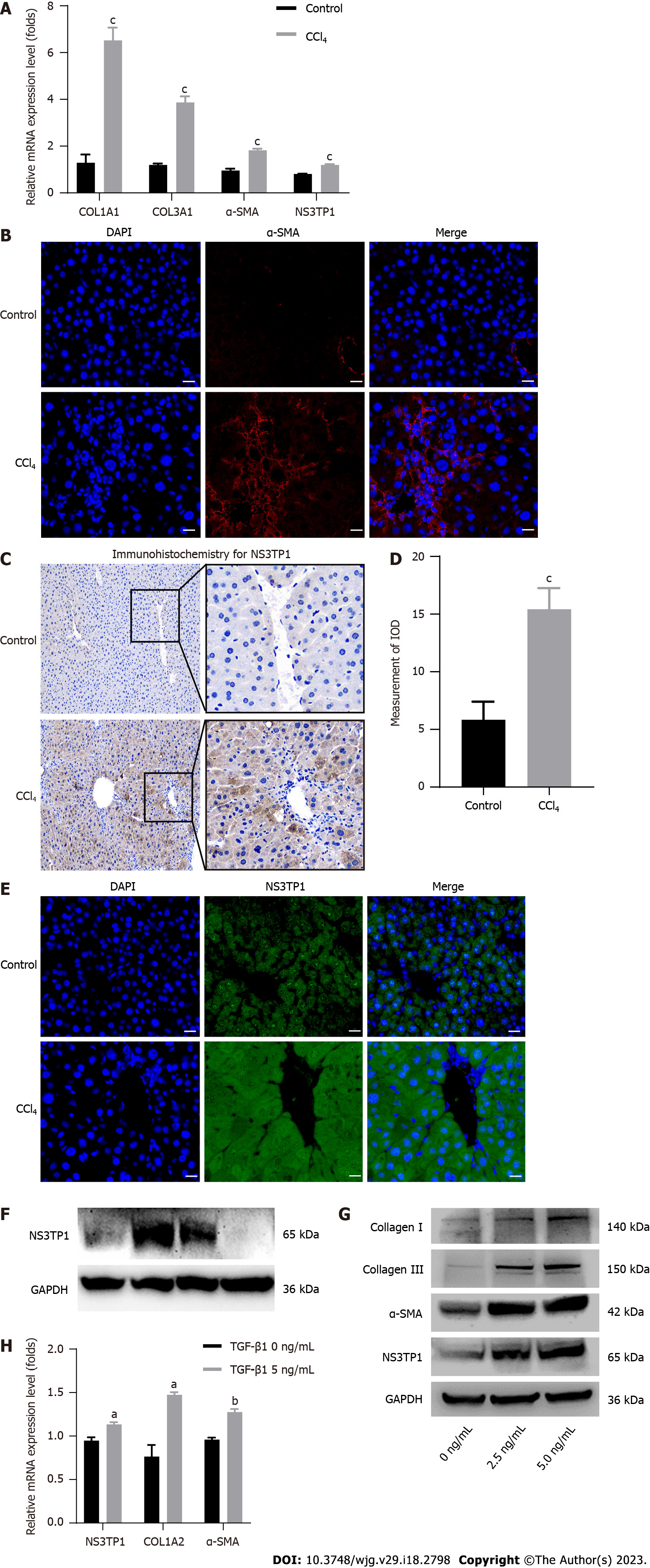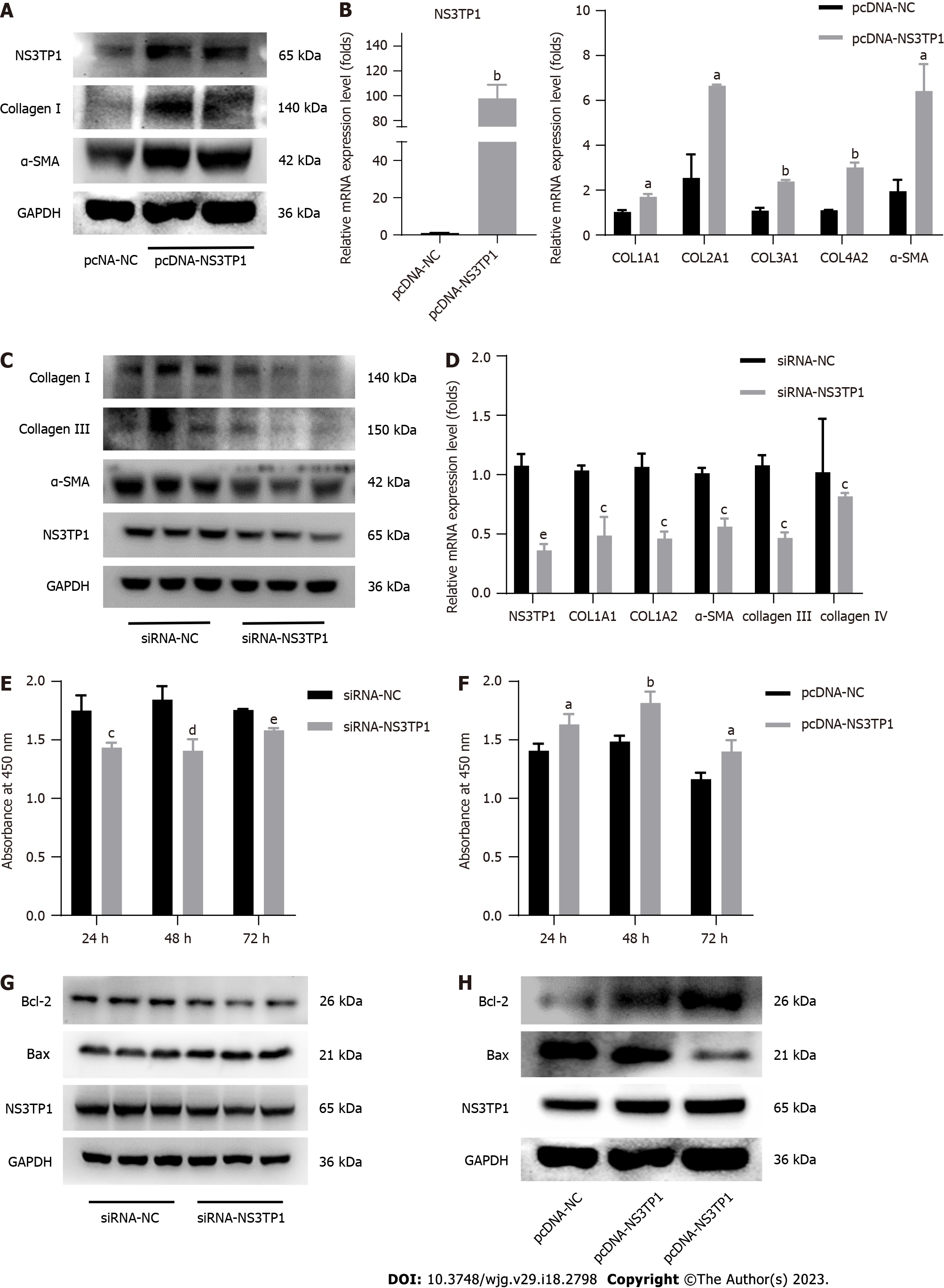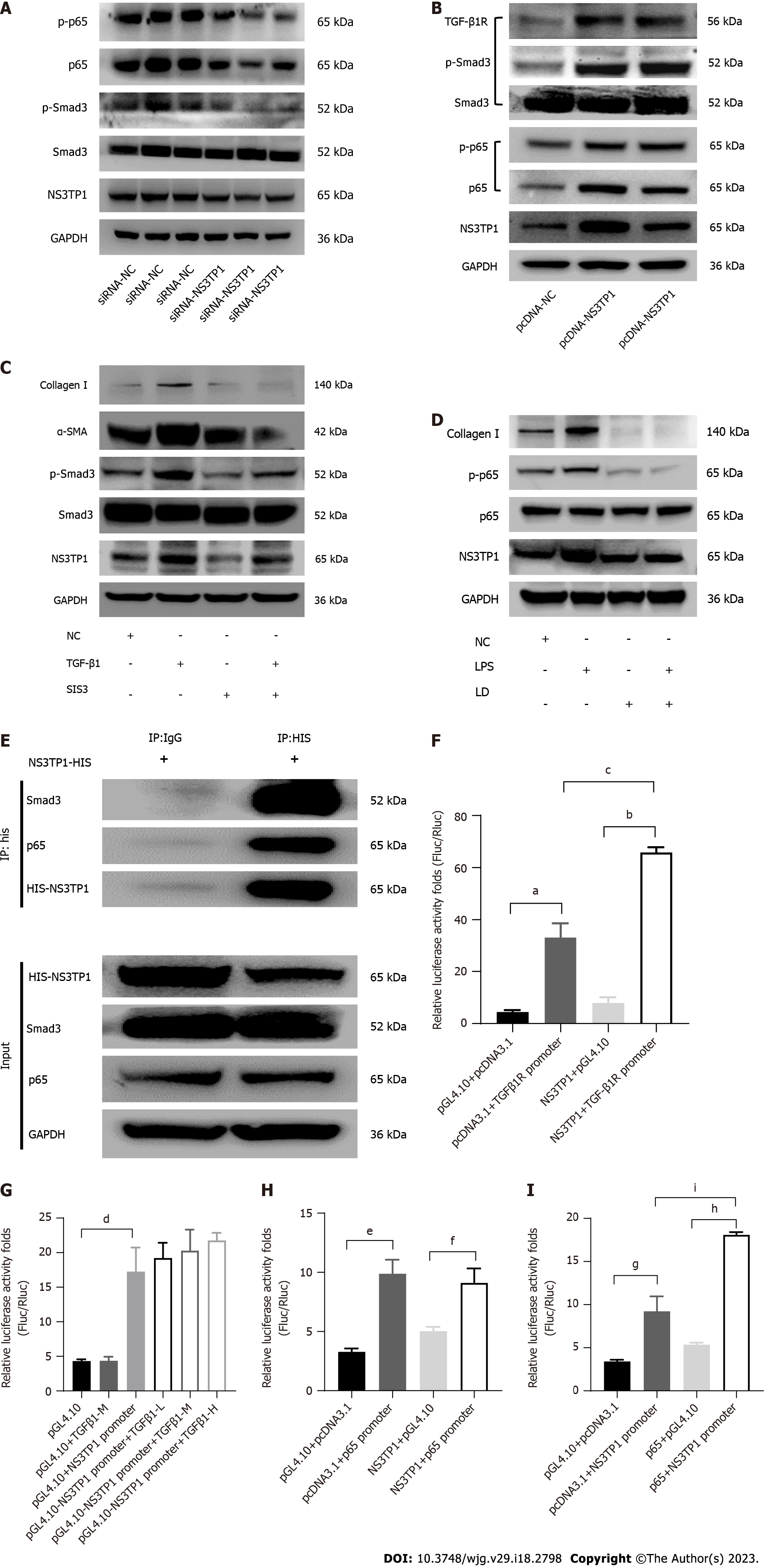Copyright
©The Author(s) 2023.
World J Gastroenterol. May 14, 2023; 29(18): 2798-2817
Published online May 14, 2023. doi: 10.3748/wjg.v29.i18.2798
Published online May 14, 2023. doi: 10.3748/wjg.v29.i18.2798
Figure 1 Evaluation of nonstructural protein 3-transactivated protein 1 expression in carbon tetrachloride-induced hepatic fibrosis and Transforming growth factor 1 beta 1-stimulated LX-2 cells.
A: Real-time quantitative polymerase chain reaction analysis of fibrosis-related genes in liver tissues (n = 6); B: Immunofluorescence staining for alpha smooth muscle actin (α-SMA); red: α-SMA (n = 3), scale bar = 20 μm; C: Immunohistochemical staining for α-SMA, scale bar = 100 μm; D: Image J analysis of immunohistochemical staining for α-SMA (n = 3); E: Immunofluorescence staining for nonstructural protein 3-transactivated protein 1 (NS3TP1); green: NS3TP1 (n = 3), scale bar = 20 μm; F: Western blot analysis of NS3TP1 in L02, LX-2, Huh7, and G2 cells; G and H: NS3TP1 was overexpressed in LX-2 cells treated with transforming growth factor 1 beta 1 (TGFβ1) for 24 h (n = 3). The data was presented as mean ± SE. aP < 0.05, bP < 0.01 vs TGFβ1 (0 ng/mL) group; cP < 0.01 vs corn oil control group. NS3TP1: Nonstructural protein 3-transactivated protein 1; TGFβ1: Transforming growth factor 1 beta 1; CCl4: Carbon tetrachloride; RT-qPCR: Real-time quantitative polymerase chain reaction; α-SMA: Alpha smooth muscle actin.
Figure 2 Influence of nonstructural protein 3-transactivated protein 1 on liver fibrosis in vitro.
A: Western blot analysis of fibrosis-related genes after Nonstructural protein 3-transactivated protein 1 (NS3TP1) overexpression (n = 3); B: Real-time quantitative polymerase chain reaction (RT-qPCR) analysis of fibrosis-related genes after NS3TP1 overexpression (n = 3); C: Western blot analysis of the fibrosis-related genes after NS3TP1 interference (n = 3); D: RT-qPCR analysis of the fibrosis-related genes after NS3TP1 interference (n = 3); E and F: Cell proliferation was measured by cell counting kit-8 assays after interference or overexpression of NS3TP1 (n = 3); G and H: Western blot analysis of Bcl-2 and Bax after interference or overexpression of NS3TP1 (n = 3). The data was represented as mean ± SE. aP < 0.05, bP < 0.01 vs pcDNA-NS3TP1 group; cP < 0.05, dP < 0.01, eP < 0.001 vs siRNA-NS3TP1 group. NS3TP1: Nonstructural protein 3-transactivated protein 1; CCK-8: Cell counting kit-8; COL1A1: Type 1 collagen alpha 1 chain; COL1A2: Type 1 collagen alpha 2 chain; COL3A1: Type 3 collagen alpha 1 chain; COL4A2: Type 4 collagen alpha 2 chain.
Figure 3 Promotion of nonstructural protein 3-transactivated protein 1 in hepatic fibrosis via transforming growth factor beta 1 receptor/Smad3 and NF-kB signaling pathways.
A and B: The protein levels of molecules in the transforming growth factor beta 1 (TGFβ1)/Smad3 and NF-kB signaling pathways after nonstructural protein 3-transactivated protein 1 (NS3TP1) interference or overexpression in LX-2 cells were analyzed by Western blot (n = 3); C and D: Western blot analysis of the above signaling pathway molecules in LX-2 cells after Smad3-specific inhibitor or licochalcone D treatment (n = 3); E: Coimmunoprecipitation analysis between NS3TP1 and Smad3 or p65; F: Luciferase activity analysis between NS3TP1 and the TGFβ1 receptor 1 (TGFβRI) promoter (n = 3); G: Luciferase activity analysis between TGFβ1 and the NS3TP1 promoter; TGFβ1 (L: 2.5 ng/mL, M: 5 ng/mL, H: 10 ng/mL) (n = 3); H: Luciferase activity analysis between NS3TP1 and the p65 promoter (n = 3); I: Luciferase activity analysis between p65 and the NS3TP1 promoter (n = 3). The data was represented as mean ± SE. aP < 0.001 pcDNA3.1 + TGFβ1R promoter vs pGL4.10 + pcDNA3.1, bP < 0.0001 NS3TP1 + TGFβ1R promoter vs NS3TP1 + pGL4.10; cP < 0.001; NS3TP1 + TGFβ1R promoter vs pcDNA3.1 + TGFβ1R promoter; dP < 0.01 pGL4.10 + NS3TP1 promoter vs pGL4.10; eP < 0.001 pcDNA3.1 + p65 promoter vs pGL4.10 + pcDNA3.1, fP < 0.01 NS3TP1 + p65 promoter vs NS3TP1 + pGL4.10; gP < 0.01 pcDNA3.1 + NS3TP1 promoter vs pGL4.10 + pcDNA3.1, hP < 0.0001 p65 + NS3TP1 promoter vs p65 + pGL4.10; iP < 0.001 p65 + NS3TP1 promoter vs pcDNA3.1 + NS3TP1 promoter. NS3TP1: Nonstructural protein 3-transactivated protein 1; TGFβ1R: Transforming growth factor beta 1 receptor; p-smad3: Phosphorylated sekelsky mothers against decapentaplegic homolog 3; SIS3: Smad3-specific inhibitor; LD: Licochalcone D; Co-IP: Coimmunoprecipitation.
Figure 4 The role of calcitriol in hepatic fibrosis.
A: Western blot analysis of collagen I and α-smooth muscle actin (α-SMA) in LX-2 cells treated with different concentrations of calcitriol; B: The protein levels of collagen I and α-SMA after calcitriol treatment at various time points were analyzed by Western blot; C: Calcitriol reduced the transforming growth factor beta 1 (TGFβ1)-induced elevation of collagen I and α-SMA at the protein level (n = 3); D: Western blot analysis of the calcitriol-induced level of Bcl-2 and Bax; E and F: An Annexin V-FITC/7-AAD kit was utilized to measure cellular apoptosis by flow cytometry; G and H: LX-2 cell migration was measured using the wound-healing test at 0 h, 24 h, 48 h, and 72 h (× 100) (n = 3); I: Hematoxylin-eosin, Masson staining, Sirius red staining, and immunohistochemical staining for α-SMA in hepatic tissue, scale bar = 100 μm; J: Immunofluorescence staining for α-SMA in hepatic tissue, red: α-SMA (n = 3), scale bar = 20 μm; K and L: Protein expression of α-SMA in the hepatic tissues was evaluated by Western blot (n = 3); M: The fibrosis score was analyzed according to the Ishak scoring system (n = 6); N: Levels of alanine aminotransferase and aspartate aminotransferase in plasma for the three groups. The carbon tetrachloride (CCl4) group was contrasted with the corn oil group, while the calcitriol group was contrasted with the CCl4 group (n = 6). The data was presented as mean ± SE. aP < 0.05, bP < 0.01, cP < 0.0001 vs without calcitriol control group; dP < 0.001 CCl4 group vs corn oil control group, eP < 0.001 calcitriol group vs CCl4 group; fP < 0.01 CCl4 group vs corn oil control group, gP < 0.01 calcitriol group vs CCl4 group; hP < 0.0001 CCl4 group vs corn oil control group, iP < 0.0001 calcitriol group vs CCl4 group. ALT: Alanine aminotransferase; AST: Aspartate aminotransferase; CCl4: Carbon tetrachloride; TGFβ1: Transforming growth factor beta 1.
Figure 5 The relationship between calcitriol and nonstructural protein 3-transactivated protein 1.
A: RT-qPCR analysis of nonstructural protein 3-transactivated protein 1 (NS3TP1) in mice treated with calcitriol (n = 6); B: Immunohistochemical staining for α-smooth muscle actin (α-SMA) in hepatic tissue, scale bar = 100 μm; C: Image J analysis of immunohistochemical staining for α-SMA, (n = 3); D: Immunofluorescence staining for NS3TP1 in liver tissue, green: NS3TP1 (n = 3), scale bar = 20 μm; E and F: Western blot analysis of NS3TP1 in LX-2 cells stimulated with various concentrations of calcitriol or with 16 μmol/L calcitriol for various durations (n = 3); G: Analysis of luciferase activity between the NS3TP1 promoter and calcitriol in HepG2 cells, calcitriol (L: 8 μmol/L, M: 16 μmol/L, H: 32 μmol/L); H: Western blot analysis of the activity of both above signaling pathways in LX-2 cells treated with different concentrations of calcitriol; I: Collagen I, α-SMA, NS3TP1, and p-p65 in calcitriol-treated LX-2 cells were measured by Western blot and compared to LPS-treated cells; J: Extracellular matrix accumulation was evaluated by Western blot in LX-2 cells stimulated with calcitriol after NS3TP1 overexpression. The data was represented as mean ± SE. aP < 0.01 CCl4 group vs corn oil control group, bP < 0.01 calcitriol group vs CCl4 group; cP < 0.0001 pGL4.10-NS3TP1 promoter vs pGL4.10, dP < 0.0001 pGL4.10-NS3TP1 promoter + calcitriol (32 μmol/L) vs pGL4.10-NS3TP1 promoter. ECM: Extracellular matrix; LPS: Lipopolysaccharide; NS3TP1: Nonstructural protein 3-transactivated protein 1; TGFβ1: Transforming growth factor 1 beta 1; CCl4: Carbon tetrachloride.
- Citation: Shi L, Zhou L, Han M, Zhang Y, Zhang Y, Yuan XX, Lu HP, Wang Y, Yang XL, Liu C, Wang J, Liang P, Liu SA, Liu XJ, Cheng J, Lin SM. Calcitriol attenuates liver fibrosis through hepatitis C virus nonstructural protein 3-transactivated protein 1-mediated TGF β1/Smad3 and NF-κB signaling pathways. World J Gastroenterol 2023; 29(18): 2798-2817
- URL: https://www.wjgnet.com/1007-9327/full/v29/i18/2798.htm
- DOI: https://dx.doi.org/10.3748/wjg.v29.i18.2798













